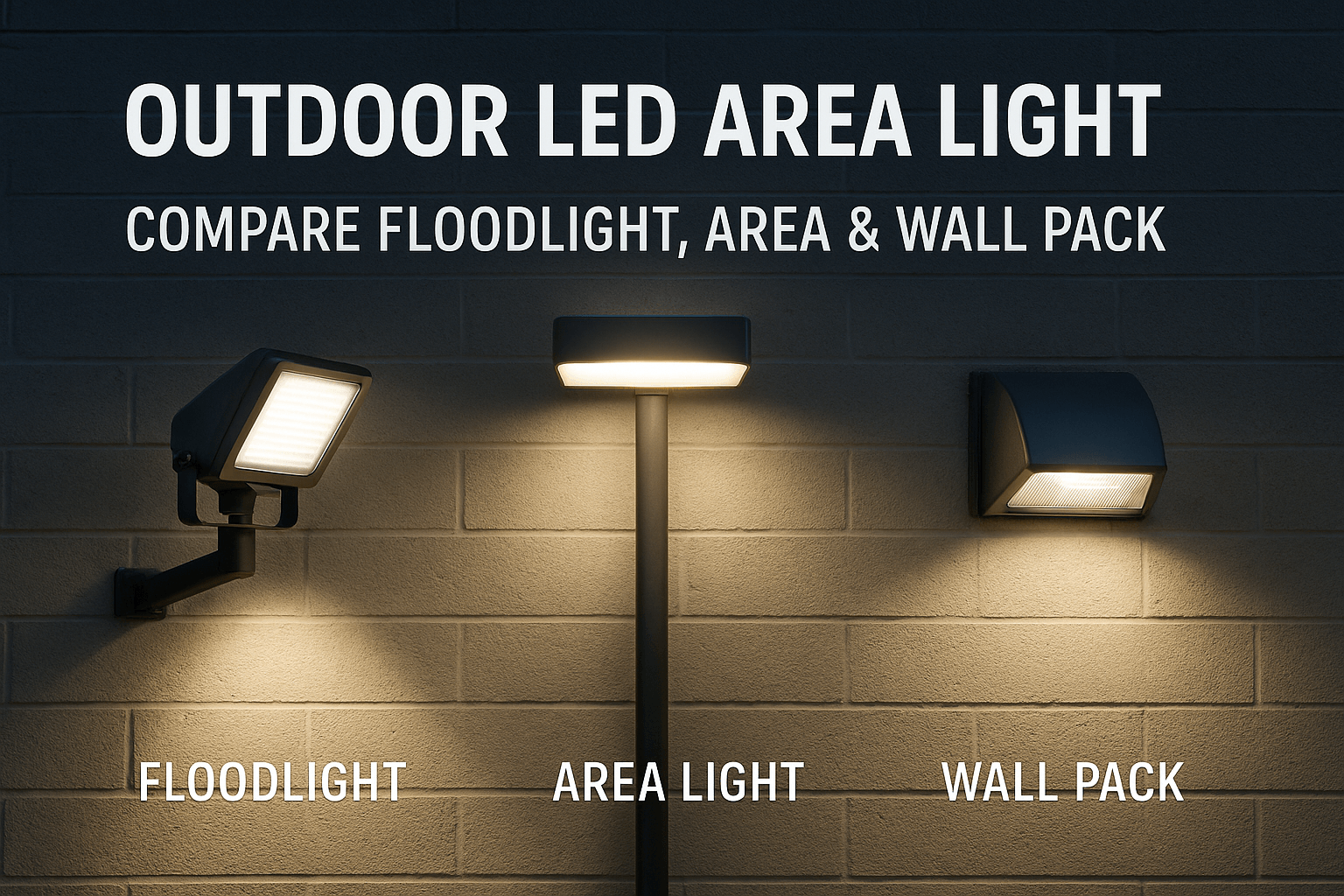
Floodlight vs. Area Light vs. Wall Pack: Choosing the Ideal Outdoor LED Area Light for Your Property
Quick Takeaway — What You’ll Gain From This Guide
- Clear definitions of floodlights, area lights, and wall packs
- A side-by-side comparison of beam patterns, mounting styles, and best-fit locations
- Decision checklist you can email to your electrician or facilities manager
- An at-a-glance ROI formula to see which outdoor LED area light pays back fastest
- Pro tips to keep neighbors, wildlife, and local code officials happy
Read on for the details (≈ 6 minutes), and you’ll walk away ready to choose—and confidently specify—the right fixture the first time.
Why “One-Size-Fits-All” Lighting Fails
Every property has pockets that need different light levels, beam spreads, and installation heights. Slapping the same outdoor LED area light everywhere wastes power, creates glare, and often violates dark-sky ordinances. Instead, think in layers:
- Safety layer for paths and parking stalls
- Task layer for loading docks and sports courts
- Accent layer for architectural flair
Floodlights, area lights, and wall packs each excel in one layer while complementing the others. Choosing the perfect mix lets you illuminate only what matters, when it matters, and for less money.
Meet the Contenders
|
Fixture Type |
Signature Strength |
Typical Mounting |
Best For |
|
Floodlight |
Long-throw beam you can aim |
Yoke or knuckle on poles & walls |
Sports courts, façade uplighting, signage |
|
Area Light |
Uniform, wide spread from height |
Tenon or slip-fitter atop poles |
Parking lots, street medians, large yards |
|
Wall Pack |
Forward-throw, cut-off pattern |
Direct surface mount on walls |
Perimeters, walkways, building exits |
Floodlight: Precision Punch With Flexible Tilt
What it is – An outdoor LED area light designed to throw a tight cone of lumens exactly where you aim it. Modern floodlights come with adjustable knuckles, 90-° yokes, or slip-fitters that lock into position.
When Floodlights Win
- Sports & recreation: A single 30,000-lumen LED floodlight mounted at 25 ft can light half a pickleball court with 40 fc.
- Sign or façade accent: Narrow 15-° optics graze brick textures without spilling light into the sky.
- Security hotspots: Adjustable heads let you paint brackets, dumpsters, or ATMs while keeping glare off cameras.
Watch-Outs
- Too many floodlights at low angles create light trespass onto neighbors’ windows.
- Narrow beams mean you may need more poles for large parking areas—compare to a wider-spread area light before buying.

Area Light (a.k.a. Shoebox): The Parking-Lot Powerhouse
What it is – A rectangular or square outdoor LED area light that mounts atop a pole and casts a uniform carpet of light. Optic lenses follow industry IES “Type II–V” distributions so you can dial coverage precisely.
Why Area Lights Rule Big Spaces
- Pole efficiency: One 150 W area light at 20 ft can replace a 400 W metal-halide and still broaden coverage.
- Dark-sky compliance: Full cut-off housings and back-light control meet BUG or U0 ratings.
- Energy dashboards love them: Upgrade a 20-pole lot and slash annual kWh by 60–70 %—a three-year payback is common.
Optimization Tips
- Stick to 4000 K or lower for hospitality zones; cool 5000 K for high-security yards.
- Run a photometric layout first; spacing-to-height ratios around 3:1 prevent striped shadows.
Wall Pack: Discreet Perimeter Guardian
What it is – A compact outdoor LED area light that mounts flush against a wall and throws light forward and slightly downward.
Where Wall Packs Shine
- Egress doors & docks: Keeps exits code-compliant at 1 fc minimum without poles.
- Retail perimeters: Aim a prismatic wall pack at 12 ft height to light sidewalks nicely while highlighting merch windows.
- Retrofit speed: Swapping an old 175 W HID wall pack for a 60 W LED takes under 20 minutes—no trenching.
Caveats
- Forward-throw optics can create glare for drivers if mounted above 15 ft; choose cut-off wall packs or add a visor.
- Coverage depth tops out around 40 ft, so combine with floodlights for deep loading bays.
Three-Way Showdown: Key Deciders
Use this “FIT” checklist before you hit “add to cart.”
- Foot-candle goals
- Floodlight = spotlight, 20–60 fc target tasks
- Area light = blanket, 2–5 fc general safety
- Wall pack = edge fill, 1–3 fc walkway code
- Installation height
- Under 15 ft? Wall pack or small flood.
- 15–30 ft? Medium flood or area light.
- 30 ft+? High-mast area lights only.
- Throw distance
- Need 100 ft of horizontal reach? Choose a flood with 30 ° optics.
- Need even 360 ° lot coverage? Choose a Type V area light.
- Total cost of ownership
- Add surge protection for Tennessee storms—only $15 but can save a $300 driver board.
- Compare rebate tiers: DLC Premium fixtures often earn 10 % higher TVA incentives.
Calculating ROI in 90 Seconds
- Find existing wattage: e.g., 400 W HID.
- Find LED replacement wattage: e.g., 150 W.
- Annual hours of use: parking lot ≈ 4,200 h.
- Energy rate: average 11 ¢/kWh.
Savings per fixture
(400 W – 150 W) × 4,200 h ÷ 1,000 × $0.11 ≈ $115/year
At $350 per DLC Premium outdoor LED area light, your payback equals three years—and that’s before utility rebates or reduced maintenance.
Installation & Maintenance Hacks
- Use slip-fitter arms on round poles; this lets you dial in exact aiming without shims.
- Seal conduit threads with silicone to prevent hornet nests in summer.
- Schedule quarterly lens cleaning—a dusty optic can drop lumen output by 10 %.
- Buy one spare driver per twenty fixtures; swapping in minutes avoids down-time fees.
Common Misconceptions Cleared Up
- “LEDs attract insects.” Warm-white 3000 K LEDs emit less UV than HIDs, so fewer bugs.
- “Higher wattage = brighter.” Optics and mounting height matter more; a 100 W LED floodlight can outshine a 200 W wall pack at the task plane.
- “All LEDs are dark-sky compliant.” Only fixtures with zero uplight (U0) earn that badge. Check labels.
Your Next Step
Choosing the optimum outdoor LED area light mix boils down to beam control, pole height, and energy math. Floodlights target, area lights blanket, wall packs fill edges. When you balance all three, you achieve:
- Safer pathways with uniform illumination
- Energy bills slashed by 50–70 %
- Beautiful façades that wow visitors after dark
Key Takeaways
- Floodlights = precision; Area lights = broad uniformity; Wall packs = perimeter fill.
- Match beam type to task layer: safety, task, accent.
- Calculate ROI quickly: watts saved × hours × rate.
- Respect dark-sky guidelines to keep regulators—and neighbors—on your side.
With this guide in hand, you’re ready to pick the perfect outdoor LED area light, reduce power bills, and illuminate your property like a pro. Happy lighting!

